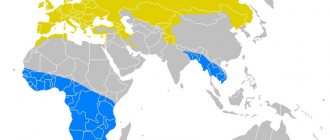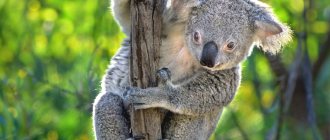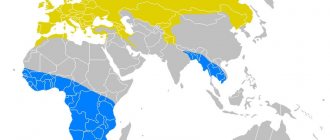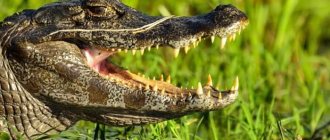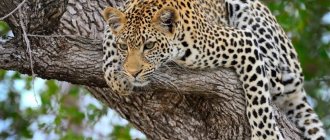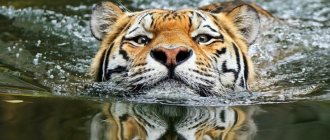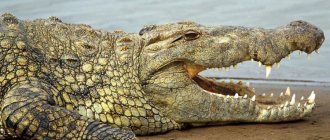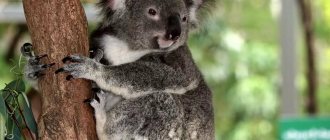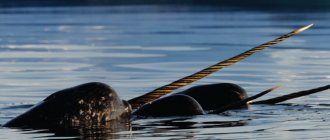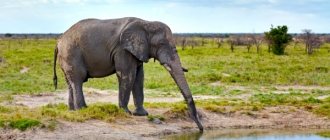Our article on the site about animals Zverey.Ru this time is dedicated to crocodiles, but in a somewhat narrow aspect. We will talk about the nutrition of these carnivorous reptiles. Adults and small individuals feed differently. You will learn things about the diet that you might not immediately believe. We will talk about the strength of a crocodile's jaws, and why it is able to cope with both large and small prey. They also swallow completely inedible objects. Which ones and why - read on.
What do small and large crocodiles eat?
Let us note right away that reptiles are predators, and crocodiles are reptiles, therefore... All crocodiles eat meat
! However, further we will have to make a few clarifications, because with crocodiles and alligators not everything is so simple...
Young, at the very beginning of life, they eat insects. As these reptiles grow older, they begin to catch larger animals. Their diet also includes fish and small frogs. Once crocodiles reach about one meter in length, they gradually switch to small mammals. For young individuals, insects, fish and frogs are the main prey.
For large (adult) crocodiles, fish still makes up the majority of the diet. The largest species can eat quite large animals, including some cattle. The footage that is usually shown on TV is actually very misleading and does not fully describe the normal behavior of crocodiles. Often this is done so that the picture for television viewers is very dramatic.
Even though crocodiles are carnivores, they also need to eat vegetables
! It sounds quite strange, but in fact, when they eat prey, they get not only its meat, but also what that animal recently ate. If there is plant material in the animal's stomach, then the crocodile gets the same thing! In captivity, crocodiles are also known to eat fruits and vegetables.
Nutrition
Crocodiles hunt mainly at night, but if prey is available during the day, the animal will not refuse to feast on it. Receptors located on the jaws help reptiles detect potential prey even at a very long distance.
The main food of crocodiles is fish, as well as small animals. The choice of food depends on the size and age of the crocodile: young individuals prefer invertebrates, fish, amphibians, adults prefer small mammals, reptiles and birds.
Very large crocodiles can easily handle victims larger than themselves. This is how Nile crocodiles hunt wildebeest during their migration; the saltwater crocodile hunts livestock during the rains; Madagascar can even feed on lemurs.
Reptiles do not chew food; they tear it into pieces with their teeth and swallow them whole. They can leave prey that is too large at the bottom to soak. Stones swallowed by animals help in digesting food; they crush it in the stomach. Stones can be of impressive size: a Nile crocodile can swallow a stone up to 5 kg.
Crocodiles do not eat carrion unless they are very weak and unable to hunt; they do not touch rotten food at all. Reptiles eat quite a lot: they can consume about a quarter of their weight in food at a time. About 60% of the food consumed turns into fat, so the crocodile can fast for up to one year if necessary.
How crocodiles catch prey and eat
And now we will talk about how these reptiles hunt. Crocodile jaws are not designed for chewing. The teeth are conical and very large, this is necessary for pushing food inside and chewing it into pieces. Because they cannot chew, crocodile sometimes have to tear off pieces of food to kill prey faster. This may seem very unpleasant, but it is necessary for the reptile, because this is the only way he can eat anything.
Crocodiles have evolved to survive at the water's edge. If you look closely at the head of a crocodile, you will see that almost all of its sense organs are located on its head. The nostrils are located on the front upper part of the jaw, where the eyes and ears are also located. The ears are small slits directly behind the eyes. With these sensory organs on the top of its head, a crocodile can almost completely disappear into the water. In this position, he can see, hear, smell and breathe, while remaining invisible and waiting for prey.
After the prey appears close, the spotted crocodile can move towards it without ripples in the water, because even while moving it is almost completely submerged. Having gotten close enough, the crocodile makes a final lightning-fast lunge, which provides it with the food it has obtained.
If a crocodile grabs an animal, but cannot easily drag it into the water, it begins to spin around it very quickly, this action first of all contributes to the loss of balance, and then completely knocks the prey off its feet. After this, the reptile can calmly pull the animal into the water, where it has no chance against strength and power. This technique has the famous term "death roll", which is used more for sensationalism than anything else. This method is the simplest and most effective for crocodiles in the process of getting their lunch.
Appearance
Short legs, flattened head and body, long and powerful tail - all this suggests that they are well adapted to living both on land and in water. These reptiles have membranes between their toes, with the help of which they swim well.
The eyes are located in the upper part of the head, which allows the crocodile to observe its victims and the situation without being noticeable - the body is entirely under water, and only the eyes and nose protrude above the water surface.
When an animal dives, special valves protect its nose and ears from water. The body is covered with horny scutes. Crocodiles typically reach a length of 2 to 5.5 m.
Jaws and bite force of crocodiles
The crocodile's jaws are extremely powerful. Bites of phenomenal strength. Although their skull is small, it allows large muscles to contract within its space. This space in the skull makes it possible to swallow large bitten pieces of prey.
Recent research shows that the bite force of large crocodiles can exceed 3,000 pounds per square inch. This is comparable to falling from the height of a small cart onto your foot. The bite of crocodiles is the strongest bite of any living animal, and perhaps even stronger than that of most dinosaurs. In fact, some scientists believe that large crocodiles have a similar bite force, comparable only in strength to a T-Rex.
Reproduction
The female lays eggs on land, burying them in the sand. Until the cubs hatch, she protects them and makes sure that birds or hyenas do not eat the offspring.
When the small crocodiles hatch, the female carries them in her mouth to the pond. At first they stay in shallow water and feed mainly on their larvae.
The mother closely monitors and protects them. After a few months, young crocodiles begin an independent life.
- the largest crocodile that was caught was more than six meters in length and weighed more than 1 ton;
- This animal is quite dangerous for humans. But there are also representatives of these reptiles that never attack - these include the species
Our article on the site about animals Zverey.Ru this time is dedicated to crocodiles, but in a somewhat narrow aspect. We will talk about the nutrition of these carnivorous reptiles. Adults and small individuals feed differently. You will learn things about the diet that you might not immediately believe. We will talk about the strength of a crocodile's jaws, and why it is able to cope with both large and small prey. They also swallow completely inedible objects. Which ones and why - read on.
Crocodiles swallow stones - this is important
Once the food is eaten, the crocodile begins to gradually digest it. The stomach of crocodiles is the most acidic environment of all animals. They can digest bones and hair, although the latter is sometimes regurgitated as small hairballs.
Among other things, stones are also an important part necessary for the normal nutrition of crocodiles. This is because stomach stones help break down food and also speed up digestion. Plus, rocks are needed as ballast to help crocodiles maintain stability while in the water.
What does he like
What do crocodiles eat in the wild? The diet of these reptiles depends on age. Since they are born no more than 20 cm in length, they initially feed on all sorts of small things: mollusks, worms, crustaceans, insects. As they grow up, they switch to fish, lizards, snakes, amphibians, birds, rodents, and turtles.
Mature crocodiles begin to hunt mammals, mainly small ones (monkeys, lemurs, pigs). The largest individuals also attack antelopes, zebras, buffalos, as well as domestic animals that come to drink. There is a known case where the remains of a rhinoceros were found in the stomach of a crocodile caught on the Nile. They do not disdain carrion occasionally. It happens that large crocodiles devour their smaller relatives.
The stomach juice of a crocodile has very high acidity, which allows it to digest not only bones, but also shells and thorns. A teenage crocodile eats up to 10% of its body weight per week, and an adult crocodile eats up to 5%.
Crocodile habitat
Modern crocodiles inhabit various fresh water bodies. Relatively few species tolerate brackish water and are found in river estuaries (African narrow-snouted crocodile, Nile crocodile, American sharp-snouted crocodile, crocodile caiman). Only the saltwater crocodile swims into the open sea (found at a distance of 600 km from the nearest shore). Crocodiles spend most of the day in the water.
Typically, crocodiles drift while continuing to breathe: the head is held horizontally just below the surface of the water, the nostrils and eyes are exposed to the air, and the body is located obliquely, descending towards the tail (or even almost vertically).
Crocodiles can dive for a long time (Mississippi alligator - up to 2 hours). In the morning and late afternoon, crocodiles come out to the coastal shallows to warm up in the sun. The most favorable body temperature for life in the Mississippi alligator is 32-35o C, and temperatures above 38o C are fatal for this species. The lower threshold of activity is about 20o.
On land, crocodiles often lie with their mouths wide open, which is apparently associated with thermoregulation: some heat loss occurs when water evaporates from the mucous membranes of the oral cavity.
Metabolic mechanisms of heat production can increase the crocodile's body temperature several degrees above ambient temperature.
Spreading
About 240 million years ago, Crurotarsans appeared on Earth - a whole group of animals in which crocodiles originated. The rest of their relatives were very large and strongly offended the newly emerging dinosaurs. Most Crurotarsans or crocodilians were basically ferocious predators that ruled the roost on land.
This dominance lasted for about 40 million years, but then a natural disaster occurred, as a result of which most crocodiles were destroyed. There was enough space on land, and rapidly multiplying dinosaurs quickly took over it. It would seem that the crocodiles could now hide in the water, but plesiosaurs had already appeared there - the natural enemies of the Crurotarsans. Both land and sea waters were occupied by permanent inhabitants, so crocodiles rushed into rivers and lakes.
Crocodiles in the form in which humanity knows them now appeared about 80 million years ago. Another 15 million years later, the next natural disaster occurred, after which the dinosaurs became extinct. It would seem that now the giant reptiles could once again become masters on land, but by that time it had already been completely populated by mammals.
At the moment, there are 25 species in the family, which have settled on different continents. The favorite habitats of these animals are warm waters, so the only continent where they cannot be found is Antarctica. But the tropical and hot zones of other continents are the home of this order.
The humid and warm climate of Africa, the Philippine Islands, Bali, Australia, Japan, North and South America contributed to the fact that many millions of years ago crocodiles came to these regions and remained here forever.
"Water" devices
The entire anatomy and physiology of these reptiles is aimed at making them feel comfortable in the water. On land, animals walk rather clumsily, although they can overtake prey with lightning speed. But in the water they are so mobile, fast, graceful and agile that few can compare with them.
The entire body is shaped to facilitate swimming. The head is elongated, which allows it to better overcome the resistance of water; the body is elongated and flattened on both sides, ending in a flattened tail, which serves as a rudder and an ideal oar at the same time. The legs are quite short, so it is uncomfortable to run on them, but they do not interfere with swimming. The toes are connected by membranes, like many aquatic animals, and this also contributes to swimming speed.
The maximum speed on land cannot be more than 14-16 km/h, and in water it approaches 35 km/h.
The structure of the skull has its own characteristics: the eyes, ears and nostrils are located on the upper side of the head. This allows the animal, while underwater, to see, hear and feel everything around, while remaining completely immersed in water, as a result of which the chances of catching prey for this predator increase significantly.
pet
At home, lovers of exotic foods feed their pets (mainly small caimans) approximately the same as what crocodiles eat in the wild. These include poultry, fish, reptiles, as well as beef and liver. It is not recommended to give crocodiles one fish to avoid developing vitamin deficiency. Vitamins B, C and calcium are added to the food of these reptiles.
Taking into account the digestion time of food, they should be fed 1-2 times a week. You need to carefully monitor the water temperature. If it becomes too cold (less than 25 C), the pet may refuse to eat.
The answer to the question of what crocodiles eat may be more concise. The toothy hunter, who lies motionless and awaits prey, eats everything that comes into his field of vision.
Unusual animal friendship (photos and videos)
2021-11-08 03:07:33
Corn porridge with milk
2021-09-29 03:58:57
Five-minute marinated lard with garlic and spices
2021-09-29 03:58:57
LAND CROCODILES AND LIZARDS WITH THE “DEVIL'S MOUTH”
No one can guarantee that African "dragons" will ever be caught, but it is well known that the "dragon" from Komodo, a small island of Indonesia, has already been caught.
But first, listen to what happened one day in Australia.
Some kind of “land crocodile” was discovered here in 1939.
In the steppes of New South Wales, thousands of miles from the nearest habitats of crocodiles, a giant reptile suddenly appeared.
The first news of the “crocodile” was brought by passengers on a train that ran between coastal villages in the north of the state. The train suddenly braked, as it seemed to the driver that a large tree was lying across the tracks. When the train stopped, people saw what kind of “tree” was blocking their path - it was... a crocodile.
No one dared to get out of the cars to drive away the monster, dozing on the rails heated by the sun.
The “brave” driver reversed and ran back at full speed.
When this story was made public, statements from farmers began to pour in to local magistrates and police.
Some reported their encounters with some kind of crocodile-like “beast.” Others allegedly heard him roar. Still others urgently asked to cleanse the area of this evil spirits.
The police, with the support of soldiers, decided to comb the entire area.
They were so diligent in their search that they even used dynamite to blow up the underground grotto. But, apart from a bunch of snakes and a huge one and a half meter lizard, they found nothing.
Meanwhile, rumors about crocodiles continued to persistently circulate in the area. The story caused a lot of noise. The mysterious crocodile from New South Wales for some time became a popular hero even in European newspapers. Tourists came to Australia to hunt this “creature”.
But nothing but large lizards and “four pairs of lovers” were discovered.
However, this is not entirely true. Something very valuable to science has been found: traces of a huge reptile. Casts from them were sent for examination to specialists at the Australian Museum in Sydney.
And what? There they came to the conclusion that the tracks belonged to a crocodile or an animal similar to it. That's how it is!
It can hardly be assumed, however, that this is an ordinary crocodile. After all, crocodiles are aquatic animals, but here we are talking about a purely land creature.
The scientists who had to say the final word remembered another similar story.
In 1912, a pilot made an emergency landing on the small island of Komodo in the Indonesian archipelago (east of Java).
He brought from there fantastic stories about dragons living on this island. Local residents call the monsters “boeaya-darat”, which means “land crocodiles”. Monsters attack goats, pigs and deer.
Needless to say, no one believed the unlucky aviator.
However, soon “dragons” were actually discovered on Komodo Island. They turned out to be giant monitor lizards of a completely new species.
P. Uwens, director of the botanical garden in Beitenzorg (now the city of Bogor on the island of Java), heard from pearl divers that there were “land crocodiles” on the island of Komodo.
He wrote about this to his friend Van Stein, a resident of the island of Flores, neighboring Komodo. Van Stein, traveling around the island of Komodo during a business trip, wrote down many different stories about these predators. They said that some of them reach a length of seven meters, that they devour deer, people and even horses, that gun bullets do not pierce their armored skin.
With a blow from its tail, a “land crocodile” can break a person in half, and a bite from its terrible teeth causes quick death.
Van Stein was very lucky: he got the skin of a two-meter “crocodile” and sent it to his friend in Bogor. Then P. Uvens immediately equipped an expedition for dragons from Komodo.
The raid began. Soon the dogs tracked down the two “crocodiles” and surrounded them, barking. The hunters ran up and threw nets over the monsters and tied them up. Then they caught two more of the same reptiles.
The reptile captives, according to local residents, were not very large, although one of them reached a length of almost three meters. Later, a four-meter "crocodile" was killed by a Dutch soldier.
When P. Uvens saw the captured monsters, he immediately realized that he was dealing not with crocodiles, but with giant monitor lizards of unprecedented size. He gave them the Latin name Varanus komodensis.
In prehistoric times, these huge reptiles lived on other islands of the Malay Archipelago. They also lived in Australia. One fossil Australian monitor lizard (Varanus priscus) was a giant even among giant monitor lizards - it reached a length of eight meters!
This gigantic lizard could easily be mistaken for a crocodile, and its lifestyle fully justified the name “land”.
The giant monitor lizard of Australia is considered long extinct.
However, the story of the “crocodile” from New South Wales gives us reason to ask whether such a conclusion is premature?
Future researchers will have to determine this.
Why does a crocodile love water?
The predator has five toes on its front paws and four toes on its hind paws.
All the crocodile's toes are connected by a membrane. Crocodiles spend a lot of time in water and to quickly move in it, the animal needs a tail and webbed paws.
The crocodile is an excellent swimmer, but on the ground it most often moves by crawling, almost like a snake, despite the presence of paws. But still, if you really need to catch up with your prey, then some crocodiles can gallop a short distance at a fairly fast pace.
Some facts about the life of crocodiles
Crocodiles have lived on the planet for about 250 million years. They existed during the time of dinosaurs and other ancient animals.
Millions of years ago, reptiles inhabited tropical and subtropical environments. They could only be found in fresh waters. They managed to adapt to different climatic conditions. After the extinction of the dinosaurs, reptiles had practically no enemies left. Therefore, they feel very bold and confident, and are considered the absolute masters of their territory. The most important and terrible enemy for a crocodile is man. Hunting animals has several goals:
- Crocodile skin is very valuable. Used for sewing clothes, shoes, accessories. The price of leather products is very high.
- Fear of falling into the massive jaws of a predator.
Some peoples still eat reptile meat and eggs to this day.
Why does a crocodile shed tears when it eats?
It is known that a crocodile often cries when it eats its prey.
There is even such an expression: “crocodile tears.” But don’t think that the crocodile is crying because he feels sorry for the one he has already eaten. Of course not! Crocodiles “cry” not out of pity, but to remove excess salt. In the form of transparent drops, it leaves the body with the help of special glands.
This is probably why no one believes in “crocodile tears” and this expression has become a household word and is applied to people trying to evoke any feeling with insincere fake tears.
Or if the tears flow in large “hails”, for example from a child (they do not have to be fake - just large). This is what they say to a loudly crying child: “don’t cry with crocodile tears.”
